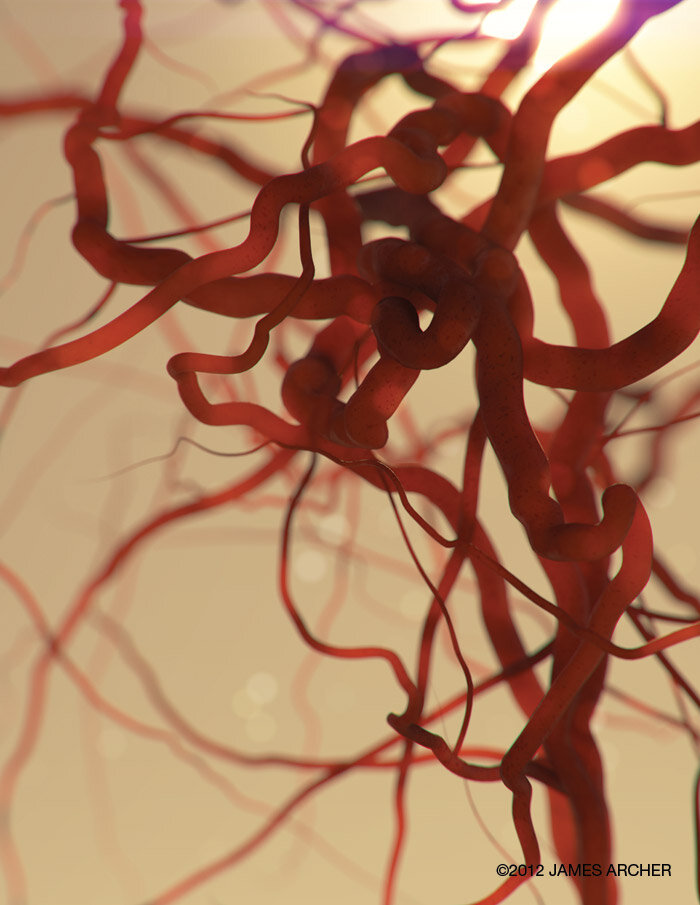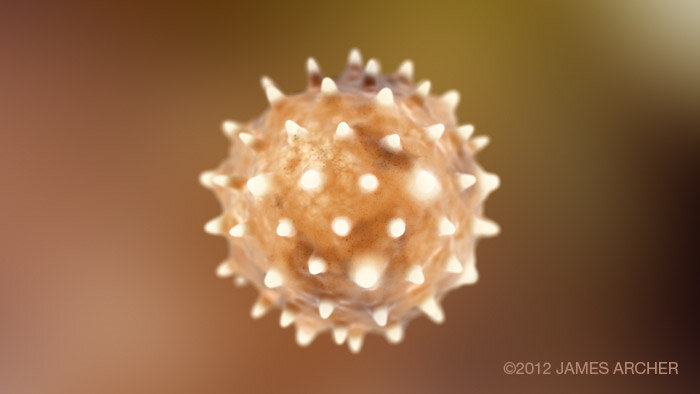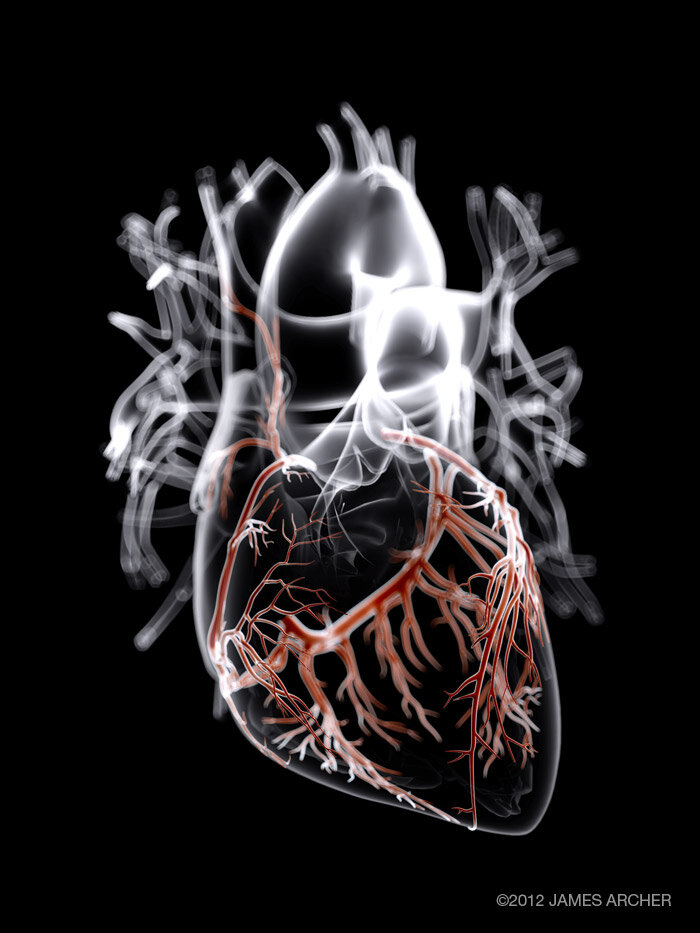Interview with James Archer of Anatomy Blue
With an MA in Biomedical Communication from UT Southwestern and tremendous experience in the medical illustration/animation scene, James Archer is particularly sought after for his artistic style and approach to work. His 3D medical illustrations captivate the viewer with their diffuse lighting, organic hues, intimate depth of field, and overall softness that make anatomy and science look almost poetic.
I had the opportunity to work with James on a medical animation project recently and for someone with such a high standard of detail and execution, he’s an extremely laid back guy. He’s also impressively nonchalant about his incredible talent. I caught up with James after our project to uncover more about his background, technique, and cool personality.
SA: Tell us a bit about your background and what pulled you into medical illustration.
JA: I grew up in North Georgia in a town called Lilburn. As a child I loved to draw, an activity that would occupy much of my time. As I grew older I developed the ability to create highly detailed, photo-realistic drawings. I would sometimes setup a still life on the kitchen table or my bedroom floor and sit there for hours recording every detail with pencil and paper. Looking back it seemed more like an obsessive-compulsive behavior than a truly artistic endeavor. I now find that there is a strong association between art and obsession.
SA: Medical illustrators tend to come from an educational background that balances science with formal art training. You received a degree in biology and art history. Why did you choose art history and not a more specific studio art degree? How has a background in art history informed your work?
JA: My decision to major in Art History was one of convenience. After graduating from high school, I was accepted at Emory University on a four-year scholarship. While Emory does not offer a BFA, receiving the scholarship was a blessing. At the time I had no money and could not possibly attend another school without student aid. Attending Emory and majoring in Art History and Biology was the logical choice.
I find that the study of Art History provides context, a sense of place and time. It provides a set of values for which to judge works. And most importantly, it provides a sense of community, a feeling of belonging.
SA: Did you specialize in 3D illustration/animation at UT Southwestern? What motivated you to go in the direction of animation as opposed to traditional medical illustration?
JA: I certainly placed a greater emphasis on 3D illustration assignments compared to traditional illustration assignments. I believe that my interest in 3D illustration and animation was nothing more than an attempt to satisfy a long held obsession to visually recreate the world around me in near photographic form. The creation of synthetic imagery is relatively straightforward with today’s software. The real challenge lies in creating imagery that is emotive.
SA: You worked for quite a few top medical education companies and organizations early in your career such as WebMD, Nucleus Medical Art, and National Library of Medicine. What experiences did you gain from these organizations and when did you decide to start your own business?
JA: Working for Nucleus and WebMD represented a turning point for me. Even though I was given some amazing opportunities at each of those companies, I discovered that I had absolutely no interest in creating purely didactic materials. Instead, I wanted to find ways of reaching people on an emotional level. If your objective is to produce positive health outcomes in a given population then your campaign must include an appeal to emotion.
Working for the National Library of Medicine proved to be the genesis for Anatomy Blue. My primary responsibilities included research and development in 3D animation and production standards for broadcast and video. While working for NLM, I was completely immersed in 3D software and rendering technology. It was during that time that I began to develop lighting and texturing techniques that would later come to define the Anatomy Blue style.

SA: Flipping through the Medical Illustration Sourcebook, your style always stands out to me for its soft colors, beautiful lighting, and intimate depth of field. You bring such an artistic touch to 3D medical illustration that is unrivaled in my opinion. Can you tell us a bit about how your style evolved into what it is today?
JA: My style is more akin to punctuated equilibrium than gradualism. Aspergillus and Virus were created nearly a decade apart but they look as if they are from the same time period.
There are a number of themes that I’m gradually refining over time, themes like obsession, realism, context and emotion. The image, Virus contains only two elements, a background and a virus, yet there is an implied story, a subtext that is supported by a heightened sense of realism, context in the absence of information. While this may all seem conjectural, I think that the purposeful consideration of these themes have helped me to create work that is unique and engaging.
SA: The name Anatomy Blue comes off as a bit mysterious, soft and melancholic, somewhat reflective of your style. Is there a story behind Anatomy Blue?
JA: I love your analysis, by the way! On its surface, Anatomy Blue is an analog of medical illustration. I agree; the name does embody a certain mystique. Coming from a medical illustrator who is obsessed with [the band] No Depression, a name like Anatomy Blue makes perfect sense.
SA: What is a typical day for James Archer like? What are the challenges of balancing family life and a self-run business?
JA: My greatest challenge is squeezing every second out of every day. I sometimes find myself obsessing over ways to optimize even the most menial of tasks. I’m sure it drives my wife crazy.
First and foremost, I am dedicated to my wife and two children. I would sacrifice my business obligations if I thought they were compromising my family life or values. That being said, balancing family life and work is not easy. The key is to set boundaries. If that means not picking-up a client call while your child is excitedly showing you their latest artistic creation, then you just let the phone ring.
SA: How is the market for medical animation doing in the US right now? As a solo medical animator, do you find it difficult to compete with the bigger shops in the US and around the world?
JA: I can’t say that I’ve seriously targeted the animation market. I’m certain that some clients will feel a sense of security knowing that their job is being handled by a small team as opposed to a solo medical animator. However, it is a segment of the market that I’m eyeing more and more each day.
SA: Apart from the ubiquitous use of skulls, what is your take on the growing trend of anatomy and art in pop culture? Does a particular artist that effectively uses anatomy in their work inspire you?
JA: The use of anatomy in art and popular cult raises more questions than answers for me. I suspect that anatomical art may help to demystify fears and ease anxieties related to human anatomy. For others, anatomical art may be a source of anxiety. Either way, I’m fascinated.
I have always found inspiration in works by James Jean. Flip, Homeopathic, and Chemistry are just a few of my favorites. His command of the human form is amazing. He designed a set of three skate decks that depict the expulsion of Adam and Eve from Eden. The tree of knowledge of good and evil is depicted as a fully dissected circulatory system. Every time I look at it I want to take up skateboarding.
SA: Thank you James!
View more of James' incredible work at anatomyblue.com!
[originally published in the AMI spring newsletter]



